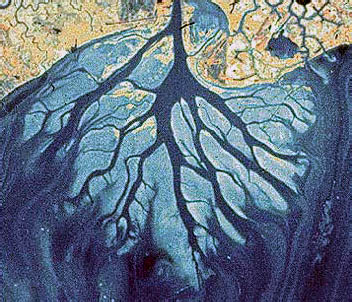The
Disappearing Delta
by Linda Pascatore on 12 September 2005
Last week I watched a segment on the PBS program NOW (see box below
for more info on this excellent program) dealing with the problems
of the coastal wetlands of New Orleans. It was an in depth analysis
of the history of the area, the natural cycle of flooding, our interference
with this cycle, and the results and implications.
The Mississippi Delta is everything between Texas and Mississippi
for about 50 miles inland. It was built over thousands of years by
the Mississippi River. The river picks up silt full of nutrients,
minerals and soil particles all along its course. There is a natural
coastal wetlands at the mouth of the Mississippi. This wetlands were
replenished and fed every few years when the river flooded, and the
silt and mud was spread over a wide area.
These wetlands made a natural buffer and protection for New Orleans
against storms and hurricanes moving over the Gulf of Mexico. As a
hurricane moved over the miles of wetlands, it would lose some of
it’s power. The wetlands would soak up a lot of the storm, and
act as a shield for New Orleans.
However, these wetlands have been disappearing at an alarming rate.
Over the past 50 years, more than 1,000 square miles of Louisiana
have been lost. Where there were wetlands, there is now the open water
of the Gulf.
There are several factors contributing to the loss of wetlands. A
Levee system was built to keep the water from overflowing the Mississippi,
but it also starves the wetlands by preventing the deposits of silt
and mud that result from the flooding. The Mississippi has been dredged
and straightened to facilitate navigation, but that also causes the
silt to go straight into the Gulf, rather than be deposited along
the way. Canals have been dug throughout the wetlands, for drainage
and to access oil deposits there. These canals have allowed salt water
to penetrate the fresh water marshes and kill vegetation.
If nothing is done to prevent this loss of wetlands, then in the next
50 years the Gulf of Mexico will move inland more than 30 miles, and
New Orleans and other coastal cities will be directly exposed to the
Gulf storms. In that case, it will not take a major hurricane to devastate
these cities: much smaller storms will be disastrous. There will also
be a 30 percent drop in fish harvest, and impacts on agriculture and
petroleum supplies.
All of this information is not new. There have been major scientific
studies and recommendations made to government commissions for years
about restoring the wetlands. It could be done for about 14 billion
dollars. Not only did the government ignore the recommendations and
not fund wetlands restoration, it also cut funding to maintain the
levee system. The disaster which has struck New Orleans has been predicted
for years.
So, what do we do now? Now is the time to rebuild the right way, restoring
the wetlands. Although it will be expensive, it will create jobs and
revitalize the local economy in New Orleans. And in the long run,
it will may save us from again spending the billions Katrina will
cost us now.
For more on this issue, check out NOW below:

Called "one of the last bastions of serious journalism
on TV" by the AUSTIN AMERICAN-STATESMAN, the PBS NOW
series occupies a unique place in the American television
landscape. For three seasons the broadcast was led by Bill
Moyers. At the helm in 2005 is veteran journalist David Brancaccio,
who joined NOW in fall 2003 after a decade as host of public
radio's MARKETPLACE.
"What do the policies set in Washington and state capitols
mean for working Americans? It may be a sound-bite society,
but there are real-world consequences and Americans are grappling
with them everyday," says Brancaccio, whose work has
been honored with a duPont-Columbia University Award and a
George Foster Peabody Award. "Each week, we're on the
ground at the nexus where the policies meet the people with
intelligent reporting and thoughtful analysis."
The vulnerability of chemical facilities to terrorist attack,
campaign finance, the future of intellectual property, public
education, the environment, and America's relationship with
the world have been the focus of NOW's exhaustive reportage.
In an important post-election year, NOW will compare the promises
to the reality — the state of national security, the
erosion of jobs, the rising cost of health care, the problems
with retirement, and the quality and availability of child
care.
Through documentary segments and interviews with original
thinkers, NOW goes beyond the noisy churn of the news cycle
and gives viewers the context to explore their relationship
with the larger world. In an era where commercial values in
journalism risk overwhelming democratic values and corporate
interests can prevail over the public interest, NOW continues
to stand apart as what THE CHRISTIAN SCIENCE MONITOR called
the "one program going against the grain."
Now is shown here in Hawaii on PBS on Friday nights at 9:00.
If you don’t have a TV, you can view transcripts and
summaries of each show, along with pointers to more resources
on each subject on their website:
http://www.pbs.org/now
|
|

